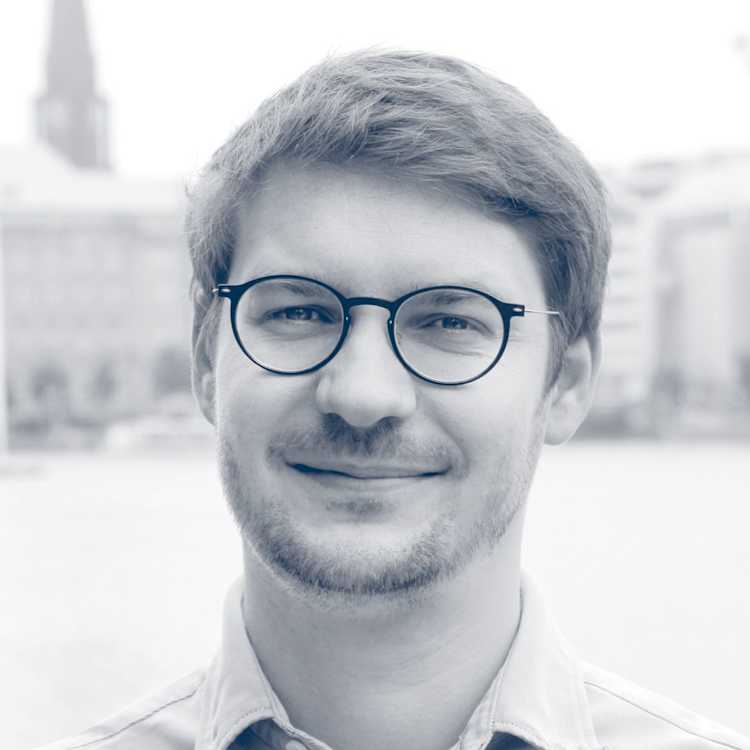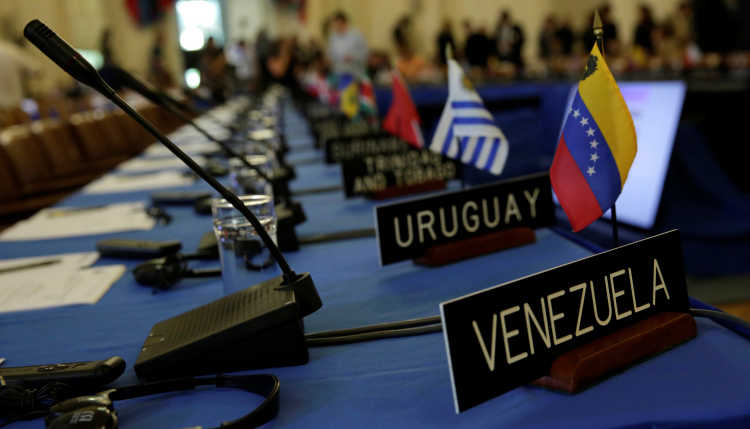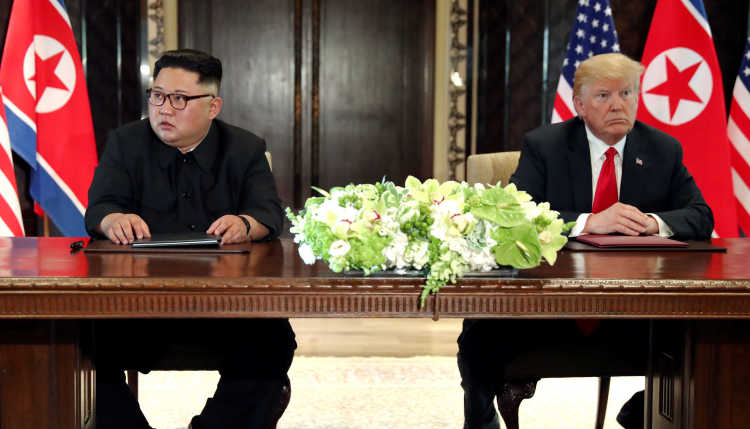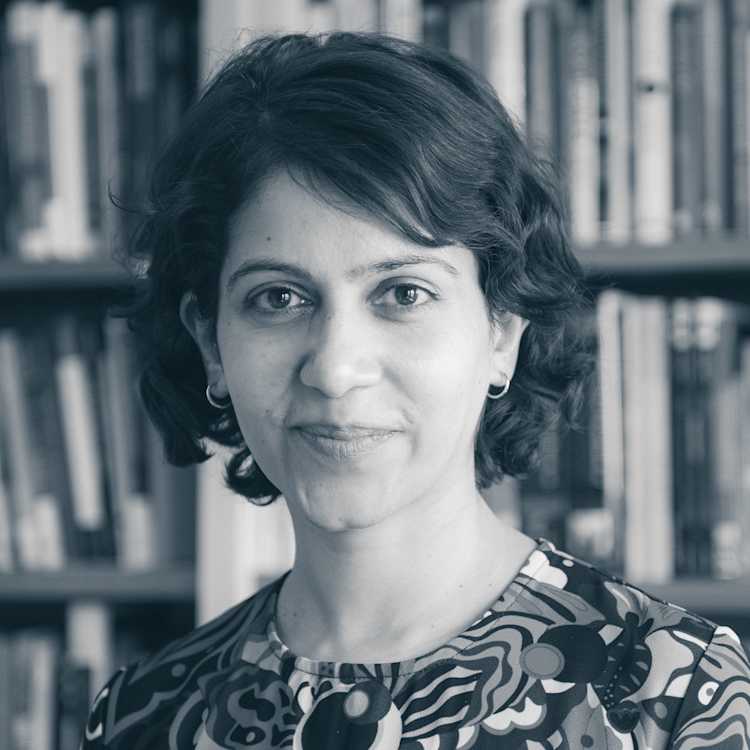- Home
- Publications
- GIGA Focus
- Three Ways to Improve Multilateral Peacekeeping in Africa (and Beyond)
GIGA Focus Africa
Three Ways to Improve Multilateral Peacekeeping in Africa (and Beyond)
Number 6 | 2019 | ISSN: 1862-3603

UN blue helmets have in many cases been an effective multilateral instrument for fostering war-to-peace transitions. But especially in Africa, where the majority of missions are deployed, peace operations suffer from a number of problems, including an underfunded region-wide African security architecture. These shortcomings severely restrict peacekeeping missions from fully realising their peacebuilding potential in Africa.
Our research shows that UN peacekeeping missions are better able to protect civilians when well-trained and well-equipped troops participate in blue-helmet missions. But it is particularly those countries with highly qualified troops, such as European or North American countries, which are reluctant to participate.
African peacekeepers are increasingly filling the rising demand for peacekeeping contributions, but they often lack the training and the capacity to effectively help missions fully achieve their goals.
Peacekeepers themselves often perpetrate crimes – for instance, sexual abuse. High-profile cases have been reported from UN missions in Liberia or the Central African Republic. These crimes undermine peacekeepers’ legitimacy and obstruct their peacebuilding potential.
Policy Implications
Three policies could help to remedy these problems and to improve the quality of peacekeeping in Africa and beyond. First, European countries, including Germany, should continue to participate in UN peace operations. Second, Germany and its allies should keep strengthening Africa’s peacekeeping infrastructure, including the African Union and other regional security initiatives. Third, to credibly push for a rules-based international order, Germany should use its position on the United Nations Security Council to press for reforms to the council and to improve the legal accountability of peacekeepers.
Successes of and Challenges for Multilateral Peacekeeping
In the broader public and in the media discourse, the success of United Nations peacekeeping missions is often underappreciated. So large loom the failures to prevent genocide in Srebrenica or Rwanda that the many relatively successful operations are often forgotten; if one considers success as the reduction of civilian and battlefield deaths, arguably one of the most important metrics by which to judge blue-helmet deployments, the missions in Namibia (UNTAG, 1989–1990), East Timor (UNMIT, 2006–2012), and Liberia (UNMIL, 2003–2018), among others, can cautiously be considered positive. An enormous amount of scholarship has evaluated the violence-reducing effect of peacekeeping operations (PKOs). In a rare case of consensus among scholars, the majority of studies conclude that PKOs, particularly on the African continent, where the majority of missions are deployed, indeed reduce the amount of violence both during and after civil wars. Missions are particularly effective in reducing violence against civilians (Fjelde, Hultman, and Nilsson 2019; Hultman, Kathman, and Shannon 2013; Ruggeri, Dorussen, and Gizelis 2018). Additionally, UN peacekeeping forces can facilitate intercommunal dialogue and thus enhance local-level cooperation (Smidt 2019).
Despite their positive impact in reducing battlefield violence and fostering a more peaceful environment, however, peace operations have come under stress. The demand for troop contributors remains high as conflicts continue in fragile contexts such as Mali, South Sudan, or Libya. These complex situations require highly trained, well-equipped troops that are able to handle a variety of tasks, including mediation, education, or training, in addition to “classical” peacekeeping tasks, such as monitoring a peace agreement. While such situations are adding to the pressures on peacekeeping missions, the majority of troop-contributing countries are facing a lack of capacity and funding for their militaries to address these pressures. And with a majority of peacekeeping troops originating from low- and medium-income countries in the Global South, and particularly sub-Saharan Africa, the need for a solid African Peace and Security architecture is more pressing than ever.
In addition, even though peacekeeping can reduce battlefield violence, PKO deployments are not universally beneficial for host countries. Reports of sexual misconduct perpetrated by peacekeeping troops, as well as economic dependencies created by the influx of foreign troops, not only harm the reputation of blue-helmet deployments, but also severely harm civilians in host countries. This problem is exacerbated by the lack of accountability that many peacekeepers face both within the United Nations and in their home countries.
These three problems of contemporary peacekeeping – lack of high-quality contributions, capacity bottlenecks within African peacekeeping structures, and PKO misconduct – significantly prevent multilateral peacekeeping from realising its full peacebuilding potential. In its role as a non-permanent member of the UN Security Council, Germany can play an active role in addressing these problems. This is particularly important to ensure an active German foreign policy that continues to be engaged in UN peace operations and that values a rules-based international order, something which is threatened by UN peacekeeping misconduct.
To outline how Germany can actively engage in changing UN peacekeeping in a meaningful way, the following sections discuss the three problems currently facing peacekeeping missions.
Why High-Quality Troops are Important for Peacekeeping
In order to protect civilians from harm during and after civil conflicts, the most important feature of a peacekeeping operation is its size. Only if enough troops are present to monitor ceasefires, troop movements, and disarmament processes can a peace operation successfully intervene when civilians are put in harm’s way (Fjelde, Hultman, and Nilsson 2019; Hultman, Kathman, and Shannon 2013). Consequently, securing an adequate number of troops for newly mandated peace operations has been a central concern for the international community (Smith and Boutellis 2013). Yet mission size alone is not a guarantor of success.
Consider the missions in the Central African Republic (CAR) and in Mali. The Multidimensional Integrated Stabilization Mission in the CAR (MINUSCA) consisted of a force of 9,000 troops in September 2015. Despite its size, however, MINUSCA failed to prevent the killing of 75 civilians in the same month. In contrast, the Multidimensional Integrated Stabilization Mission in Mali (MINUSMA) only consisted of 5,000 troops. Even though MINUSMA was operating in a country twice the size of the CAR and with a substantially lower number of troops, the UN operation successfully stabilised the situation in Mali and monitored the presidential elections in August 2013. Why was MINUSMA more successful than the UN mission in the CAR?
An Amnesty International (AI) report from the CAR gives us a first indication. The report cites major gaps in the training and equipment of the troops that participated in MINUSCA. AI quotes a MINUSCA member as stating, “[w]hen there’s gunfire, we can only send the guys in armored vehicles. But several of these are currently out of service. [...] This reduces our capacity of intervention” (Amnesty International 2016). These deficiencies in troop quality severely limited MINUSCA’s ability to fulfil its mandate to protect civilians.
MINUSMA in Mali had far fewer problems with troop quality, training, and equipment. The mission consisted of, inter alia, highly trained troops from countries with advanced militaries, such as the Netherlands, Germany, Norway, and Finland. These high-quality troop contributions put MINUSMA in a much better position to protect civilians from harm. The differing experiences between the missions in CAR and Mali suggest that, in addition to the size of peacekeeping missions, what also matters is the quality of the troops deployed. Indeed, we observe a large variation in the average quality of UN peacekeeping missions in Africa (see Figure 1).
In a recently published article in the Journal of Peace Research, we formally test the idea that mission quality and a mission’s ability to protect civilians are linked (Haass and Ansorg 2018). We identify a number of channels through which better-trained and better-equipped troops can protect civilians. First, better-equipped peacekeepers are more able to create buffer zones between combatants and to monitor ceasefires in the host countries, which are often extremely large and thus present logistical challenges for ill-equipped missions. Consequently, high-quality peacekeepers can better deter combatants from attacking civilians. What is more, countries with advanced militaries that possess these qualities often also accompany their military missions with diplomatic pressure on the conflict parties to end the violence. Together, better equipment, better training, and diplomatic effort should enable peace operations to more effectively protect civilians, even when the missions are similar in size to less well-equipped ones.
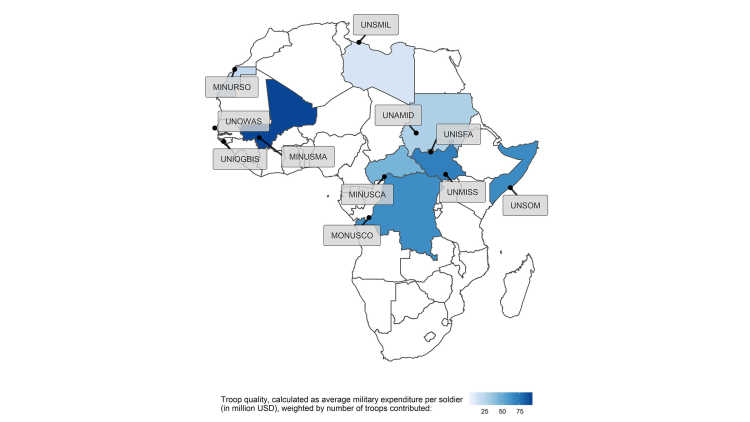
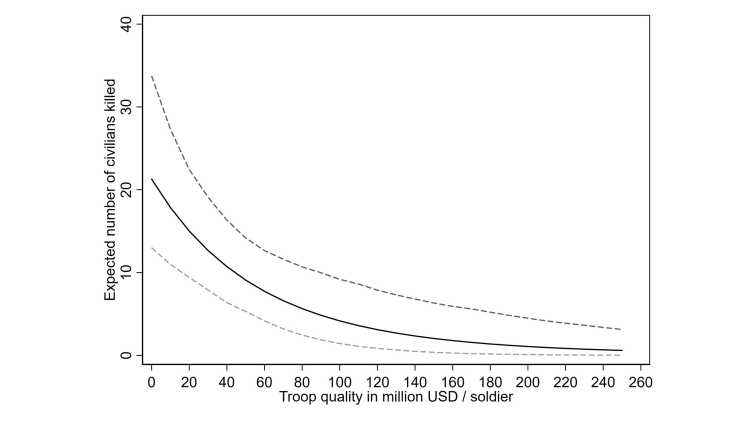
We investigate this proposition through a formal statistical test of peacekeeping missions in 70 conflict episodes in Africa and Asia. Figure 2 shows the statistical predictions that result from this exercise. The plot shows that as the average military spending of a mission’s troop-contributing countries increases, the predicted number of civilian killings decreases (see box for a description of how to measure peacekeeping mission quality). This suggests a positive effect of troop quality on the mission’s ability to protect civilians. Crucially, this prediction is derived from statistical models that take into account troop size. It is therefore an independent effect and is not driven by large missions that also have more contributions from countries with high levels of military spending.
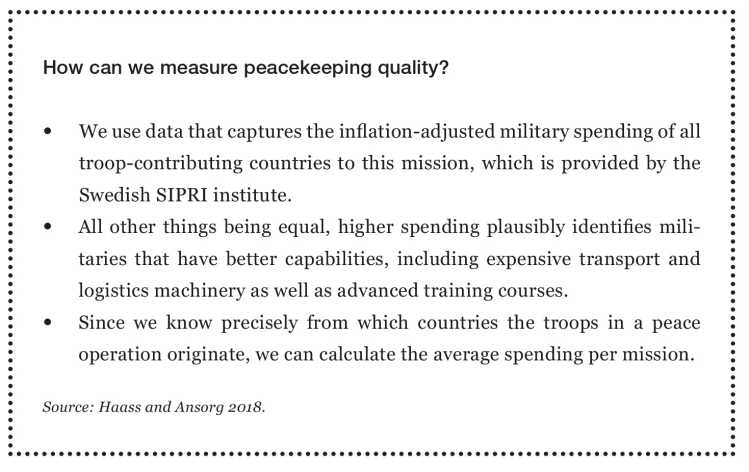
These findings underscore the importance of contributions from countries with advanced military equipment and training in order for peace operations to fulfil their protection mandates.
Why Strong Regional Peacekeeping is Important for Peacekeeping
At the same time, the importance of regional peacekeeping should not be underestimated. The majority of peacekeeping missions are implemented on the African continent, and it is also African countries that account for the majority of the troops sent to these missions – both UN peacekeeping missions and regionally organised operations (Ansorg and Haass 2013; UN Peacekeeping n.d.). While the UN’s cooperation with regional organisations is explicitly mentioned in the UN Charter, and mandated by Chapter VIII, the UN’s strong engagement with the African Union in questions of peacekeeping also reflects the particular needs of the continent. Figure 1 displays the operations and political missions deployed by various regional organisations on the African continent.
Having adopted the principle of Responsibility to Protect, the African Union is quite unique among regional organisations with regard to interventions in violent conflicts and major crises (Haysom and Pedersen 2015). Generally, the UN, the EU, and bilateral partners encourage the organisation in strengthening the African Peace and Security Architecture. Contributions by African countries themselves are instrumental in maintaining peace and order on the continent, with African Union Mission in Somalia (AMISOM) and the UN-EU-AU cooperation in Mali within the framework of MINUSMA representing only two of the more prominent examples.
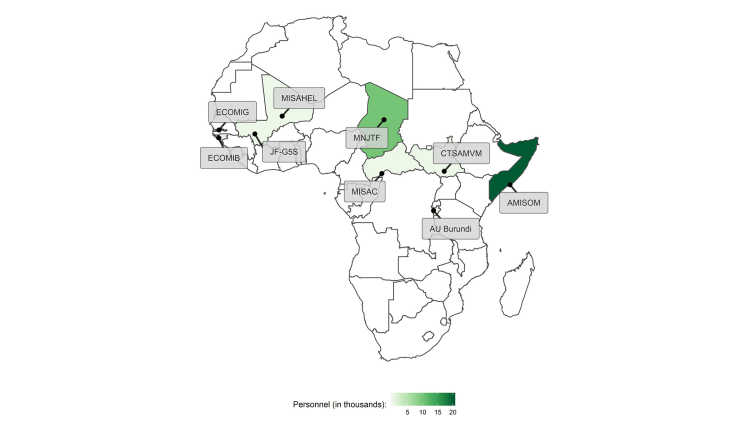
This development has both positive and problematic implications. On the one hand, the increasing participation of African peacekeepers in peace operations on the continent signals a devolution of peacekeeping tasks: regional organisations and affected countries are taking care of regional crises. This not only improves the legitimacy of operations, but also adds to their effectiveness, because peacekeepers with knowledge of local languages, customs, and politics are engaging in peacekeeping tasks. The faster deployment and greater political commitment of neighbouring countries also adds to the benefits of regional peacekeeping. This division of labour between regional and international organisations, in turn, allows for the more effective allocation of each organisation’s resources. The UN could, for instance, focus much more productively on more severe crises if regional organisations would handle less severe situations. Additionally, contributions to peacekeeping missions also facilitate improved access to international forums for troop-contributing countries, as well as stronger bilateral relationships with other contributing countries (Haysom and Pedersen 2015).
On the other hand, regional peacekeeping might have detrimental effects for civilians: they might be exposed to poorly trained and poorly paid troops with little respect for humanitarian conduct within the framework of a peacekeeping mission. In 2014, for example, Chad had to withdraw all its troops from the mission in the Central African Republic after being accused by the UN of having fired on a civilian market, without provocation (Haysom and Pedersen 2015).
Linked to this is the notorious lack of funding for regional peacekeeping initiatives. For example, from its inception AMISOM has lacked sufficient resources to sustain such a large peacekeeping force. It has thus been always dependent on the EU, which pays the salaries of the peacekeepers. Given that sufficient funding of troops, equipment, and training is crucial to their success (see above), this funding crisis negatively affects these missions’ ability to properly fulfil their mandates.
The lack of funding and a reliable, well-organised and effective African Peace and Security Architecture prevents regional initiatives from delivering on their potential for effective peacekeeping on the ground. The Malian crisis of 2012 is a notorious example, and explains the Sahelian states’ need to eventually establish their own ad hoc security initiative, the G5 Sahel. This relatively new player in the African security landscape might indicate the potential of smaller and more flexible answers to pressing issues in the region, such as the threats from jihadist organisations operating there (AQIM, MUJWA, Al-Mourabitoun, Boko Haram).
Why Peacekeeper Conduct Affects Mission Success
But it is not just troop quality or funding and political support for regional peacekeeping initiatives that are important ingredients for mission success. Another feature of peace missions plays an often overlooked but very critical role: the conduct of peacekeepers towards the population they are tasked with protecting. One of the most important types of misconduct in this context is sexual exploitation by peacekeepers. This exploitation often takes the form of transactional sex – for example, sex in exchange for money or gifts – or in some cases even rape. For example, UN peacekeepers from the MINUSCA mission in the Central African Republic have repeatedly faced allegations of the sexual abuse of civilians.
Studies indicate that these patterns of sexual exploitation are widespread. One study finds that in Liberia, a large majority of survey respondents reported having engaged in transactional sex with UN personnel during the mission, from 2003 on, that followed the Liberian civil war (Beber et al. 2017). Other studies find that the presence of UN peacekeepers is positively associated with increases in sex trafficking within and around the country that is hosting a mission (Bell, Flynn, and Martinez Machain 2018).
Exacerbating this problem is the fact that peacekeeping troops typically remain under the jurisdiction of the troop-contributing country. This means that the UN’s hands are often tied in prosecuting any violation perpetrated by the troops under the UN flag, since it is up to the contributing state to implement any punishment.
This misconduct is problematic for a number of reasons. First, peacekeepers’ sexual exploitation of the very people they are supposed to protect inflicts immeasurable suffering on an already traumatised, vulnerable population. Ending this suffering must be the utmost guiding principle of every peace operation. It is not enough to simply limit physical violence against civilians. Instead, the personnel of peacekeeping missions must themselves act according to the highest moral standards.
Second, sexual misconduct undermines a peace operation’s legitimacy within the population it is intended to serve. Peacekeepers’ violation of the population they are supposed to protect (even if only a minority of the entire mission engages in these violations) might cause civilians to become less inclined to cooperate with peacekeepers or provide them with truthful information. Yet this cooperation with locals is a crucial component of peacekeeping success (Ruggeri, Gizelis, and Dorussen 2013).
Third and more broadly, any continuation of this type of misconduct undermines a rules-based international order which rests on universally valid human rights, as promoted by the European Union and German foreign policy (Bundesregierung 2017). Allowing the practice of sexual abuse by peacekeepers to continue calls into question the credibility of a foreign policy that aims to promote human rights.
Three Avenues to Improving Peacekeeping in the Twenty-First Century
We suggest three ways to address the challenges linked to troop quality and training, regional peacekeeping, and peacekeeping misconduct.
To improve the overall quality of troop contributions to peace operations (and thus improve their effectiveness in protecting civilians), countries with advanced militaries need to continue and possibly even increase their contributions to blue-helmet operations. The success of German and Dutch deployments in Mali demonstrates that these contributions include Western engagement under the auspices of the United Nations. We want to emphasise that this is not a call for unilateral or multilateral military intervention. Instead, we suggest strengthening the multilateral engagement of troops from countries with highly trained and well-equipped militaries alongside military engagement from within the region, embedded in a multilateral political framework supported by the UN Security Council. Such strengthening does not necessarily have to entail troop contributions, but could also be provided in the form of increased support for training facilities (such as increased support for the Kofi Annan International Peacekeeping Training Centre in Ghana), diplomatic support in addition to a UN mission, support for human rights training, or the provision of civilian logistics capacities.
Given that the EU is an important funder of African peacekeeping missions (see above), trilateral cooperation between the UN, the AU, and the EU should be encouraged and institutionalised (Aris and König 2018). This cooperation does not come without problems, as the French engagement in MINUSMA shows. Issues regarding the prioritisation of policies and funding could be tackled, for instance, with a clearer and more institutionalised division of labour and better coordination between the various organisations involved.
Most importantly, increased cooperation between UN, EU, and African regional organisations also entails giving greater weight to African voices in negotiations about African peacekeeping deployment. In the aftermath of the Libyan crisis, for example, the AU criticised the UN Security Council for not listening to its suggestion for an explicitly political solution. In addition, almost all mandates for robust peacekeeping are issued by powerful countries such as the US, France, or Britain, which have their own political, security and economic interests in mind (Haysom and Pedersen 2015). While these interests might not be detrimental to African interests, it is crucial to have African buy-in in any deployment. In the long run, this might also mean reforming the veto power within the Security Council and giving the African block a permanent seat (with rotating membership for increased representation).
Curbing sexual misconduct by peacekeepers also requires policy efforts. We know that the participation of peacekeepers from countries with strong gender-equality norms can reduce the number of allegations brought forward against peacekeepers (Karim and Beardsley 2016). Consequently, troop-contributing countries need to be encouraged to uphold such general human rights norms in their continued engagement in blue-helmet operations. Given that most of the countries with strong gender-equality norms also have advanced militaries with adequate training and high-tech equipment, their deployment would also improve the overall quality of the peace operations. Incorporating gender norms in training curricula could also contribute to reducing peacekeepers’ normative predisposition to engage in misconduct.
But this is clearly not enough. UN member states need to implement stronger accountability and monitoring procedures that prevent troops in the field from misconduct. They should strive to implement UN Security Council resolution 2272, enacted in 2016, which aims to reduce sexual misconduct by peacekeepers more forcefully by making it a cornerstone of new mandates – similarly to resolution 1325, which highlighted the role of women in armed conflicts. Any reports of misconduct need to be rigorously investigated, and potential perpetrators need to be brought before an independent court. A zero-tolerance policy with respect to sexual exploitation and abuse needs to be implemented on all levels.
Finally, troop-contributing countries should strive to increase the share of women in peace operations. Currently, females represent only 3 per cent of UN military peacekeepers, and the share of women in UN police missions is 10 per cent. However, there is some evidence that links women’s participation in peace operations to a reduction in misconduct allegations against these operations (Karim and Beardsley 2016). Consequently, increasing the number of women might help curb the problem of peacekeeper misconduct. More important, however, is that troop-contributing countries foster, monitor, and implement gender-equality norms in all the troops they deploy to peace operations, irrespective of the gender of the individual soldiers.
These measures to strengthen troop quality, regional peacekeeping, and accountability against peacekeeper misconduct are neither a panacea nor the only measures available to improve peacekeeping effectiveness. For instance, member states must also strengthen the UN in general, first and foremost by paying their budget contributions – a constant issue plaguing the institution and greatly inhibiting its proper functioning. But by specifically improving troop quality, regional security architectures, and accountability measures, the international community can help peace operations achieve their full potential as an effective multilateral instrument with which to contain violence and promote peace.
Footnotes
References
Amnesty International (2016), Mandated to Protect, Equipped to Succeed? Strengthening Peacekeeping in Central African Republic, London: Amnesty International, www.amnesty.org/en/documents/document/?indexNumber=afr19%2f3263%2f2016&language=en (21 October 2019).
Ansorg, Nadine, and Felix Haass (2013), Multilaterale Friedenssicherung in Afrika, GIGA Focus Afrika, 6, December, www.giga-hamburg.de/en/publication/multilaterale-friedenssicherung-in-afrika (21 October 2019).
Aris, Stephen, and Kirsten König (2018), Long-Distance Relationships: African Peacekeeping, CSS Analyses in Security Policy, 236, www.research-collection.ethz.ch/handle/20.500.11850/308337 (21 October 2019).
Beber, Bernd, Michael J. Gilligan, Jenny Guardado, and Sabrina Karim (2017), Peacekeeping, Compliance with International Norms, and Transactional Sex in Monrovia, Liberia, in: International Organization, 71, 1, 1–30.
Bundesregierung der BRD (2017), Krisen Verhindern, Konflikte Bewältigen, Frieden Fördern. Leitlinien Der Bundesregierung, Berlin: Regierung der Bundesrepublik Deutschland, www.peacelab2016.de/fileadmin/user_upload/170614-Leitlinien_Krisenpraevention_Konfliktbewaeltigung_Friedensfoerderung_DL.pdf (21 October 2019).
Fjelde, Hanne, Lisa Hultman, and Desirée Nilsson (2019), Protection Through Presence: UN Peacekeeping and the Costs of Targeting Civilians, in: International Organization, 73, 1, 103–131.
Haass, Felix, and Nadine Ansorg (2018), Better Peacekeepers, Better Protection? Troop Quality of United Nations Peace Operations and Violence against Civilians, in: Journal of Peace Research, 55, 6, 742–758.
Haysom, Simone, and Jens Pedersen (2015), Robust Peacekeeping in Africa: The Challenge for Humanitarians, Humanitarian Practice Network, https://odihpn.org/magazine/robust-peacekeeping-in-africa-the-challenge-for-humanitarians/ (21 October 2019).
Hultman, Lisa, Jacob Kathman, and Megan Shannon (2013), United Nations Peacekeeping and Civilian Protection in Civil War, in: American Journal of Political Science, 57, 4, 875–891.
Karim, Sabrina, and Kyle Beardsley (2016), Explaining Sexual Exploitation and Abuse in Peacekeeping Missions: The Role of Female Peacekeepers and Gender Equality in Contributing Countries, in: Journal of Peace Research, 53, 1, 100–115.
Ruggeri, Andrea, Han Dorussen, and Theodora-Ismene Gizelis (2018), On the Frontline Every Day? Subnational Deployment of United Nations Peacekeepers, in: British Journal of Political Science, 48, 4, 1005–1025.
Ruggeri, Andrea, Theodora-Ismene Gizelis, and Han Dorussen (2013), Managing Mistrust: An Analysis of Cooperation with UN Peacekeeping in Africa, in: Journal of Conflict Resolution, 57, 3, 387–409.
Smidt, Hannah M. (2019), United Nations Peacekeeping Locally: Enabling Conflict Resolution, Reducing Communal Violence, in: Journal of Conflict Resolution, July, online first: DOI 0022002719859631.
Smith, Adam C., and Arthur Boutellis (2013), Rethinking Force Generation: Filling the Capability Gaps in UN Peacekeeping, New York: International Peace Institute.
UN Peacekeeping (n.d.), Troop and Police Contributors, United Nations, https:// peacekeeping.un.org/en/troop-and-police-contributors (21 October 2019).
General Editor GIGA Focus
Editor GIGA Focus Africa
Editorial Department GIGA Focus Africa
Regional Institutes
Research Programmes
How to cite this article
Ansorg, Nadine, and Felix Haaß (2019), Three Ways to Improve Multilateral Peacekeeping in Africa (and Beyond), GIGA Focus Africa, 6, Hamburg: German Institute for Global and Area Studies (GIGA), https://nbn-resolving.org/urn:nbn:de:0168-ssoar-65598-4
Imprint
The GIGA Focus is an Open Access publication and can be read on the Internet and downloaded free of charge at www.giga-hamburg.de/en/publications/giga-focus. According to the conditions of the Creative-Commons license Attribution-No Derivative Works 3.0, this publication may be freely duplicated, circulated, and made accessible to the public. The particular conditions include the correct indication of the initial publication as GIGA Focus and no changes in or abbreviation of texts.
The German Institute for Global and Area Studies (GIGA) – Leibniz-Institut für Globale und Regionale Studien in Hamburg publishes the Focus series on Africa, Asia, Latin America, the Middle East and global issues. The GIGA Focus is edited and published by the GIGA. The views and opinions expressed are solely those of the authors and do not necessarily reflect those of the institute. Authors alone are responsible for the content of their articles. GIGA and the authors cannot be held liable for any errors and omissions, or for any consequences arising from the use of the information provided.





